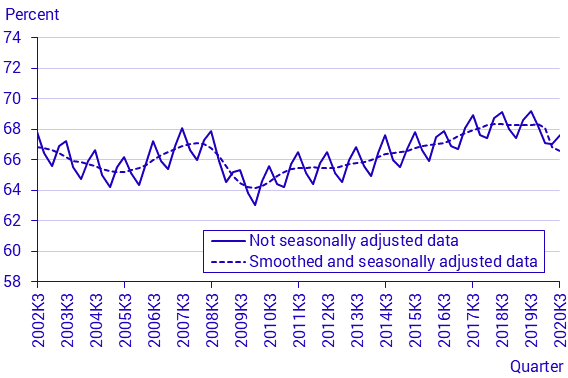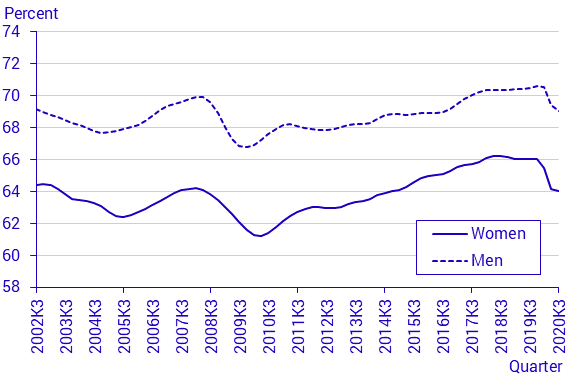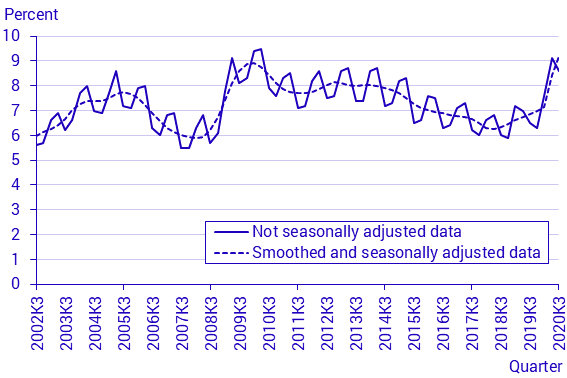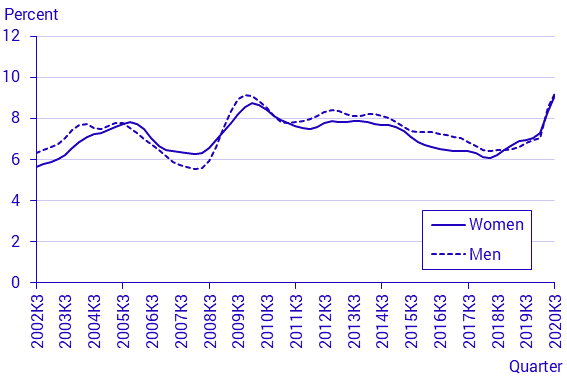Labour Force Surveys (LFS), 3rd quarter 2020
Sharp deterioration in the labour market for young people and foreign born persons
Statistical news from Statistics Sweden 2020-10-27 9.30
In the third quarter of 2020, the employment rate among persons aged 15–74 years was 67.6 percent, down by 1.6 percentage points compared with the same quarter a year ago. The unemployment rate increased by 2.1 percentage points to 8.6 percent. The largest increase was among persons aged 15–24 years and foreign born persons. The average number of hours worked amounted to 130.7 million per week, a decrease of 4.3 percent, calendar-adjusted. Seasonally adjusted and smoothed data shows that unemployment continues to rise.
The labour force
There were 5 576 000 persons in the labour force aged 15–74 years in the third quarter of 2020, non-seasonally adjusted. Among the people in the labour force, 2 642 000 were women and 2 934 000 were men. The labour force participation rate was 74.0 percent. For women it was 71.4 percent, and for men it was 76.5 percent. The relative labour force participation rate among young people aged 15–24 years was 54.2 percent, which is a decrease of 4.2 percentage points compared with the third quarter of 2019.
Seasonally adjusted and smoothed data shows that there were 5 525 000 persons in the labour force, which corresponds to 73.3 percent of the population. The labour force participation rate is at the same level as in the first quarter of 2020, when the effects of the COVID-19 pandemic had not yet had a major impact on the Swedish labour market.
Employment
In the third quarter of 2020, there were 5 096 000 employed persons aged 15–74 years, non-seasonally adjusted, which is 103 000 fewer than in the corresponding quarter of 2019. Employment decreased among both women and men. The number of employed women was 2 413 000, down by 48 000, and the number of employed men was 2 683 000, down by 55 000. The largest decrease was noted in Västra Götaland County, where the number of employed persons decreased by 28 000 compared with the third quarter of 2019. The number of employed persons decreased by 12 000 persons in Gävleborg County.
The employment rate decreased by 1.6 percentage points and amounted to 67.6 percent. Among women, it was 65.2 percent, which is a decrease of 1.5 percentage points, and among men it was 69.9 percent, which is a decrease of 1.7 percentage points. The employment rate among young people aged 15–24 years decreased by 6.6 percentage points compared with the third quarter of 2019, and amounted to 42.1 percent. The employment rate also decreased among those aged 25–44 years.
According to seasonally adjusted and smoothed data, there were 5 018 000 employed persons. This is a decrease of 107 000, of whom 53 000 were young people, compared to the first quarter of 2020. The employment rate was 66.6 percent, down by 1.5 percentage points compared with the first quarter of 2020.
Employees
In the third quarter of 2020, there were 4 588 000 employees, non-seasonally adjusted, which is a decrease of 99 000 compared with the corresponding quarter of the previous year. Among women, the number of employees decreased by 48 000 to 2 273 000, and among men the number of employees decreased by 51 000 to 2 315 000. There were 3 842 000 permanent employees, of which 1 857 000 were women and 1 985 000 were men. The number of temporary employees decreased by 74 000 and amounted to 746 000. Among temporary employees, 417 000 were women. The number of temporary employed decreased among men by 46 000 and amounted to 330 000.
Compared with the first quarter of 2020, seasonally adjusted and smoothed data shows a decrease in the number of employees by 103 000, of whom 86 000 were temporary employees.
Hours worked
The average number of hours worked in the third quarter of 2020 amounted to 130.7 million per week, non-seasonally adjusted. This is a decrease of 4.3 percent, calendar adjusted, compared with the third quarter of 2019. The largest decrease was in the hotels and restaurants industry, in which the number of hours worked, calendar adjusted, decreased by 25.0 percent compared with the third quarter of 2019. The number of hours worked decreased by 17.1 percent in the transport industry and by 10.0 percent in the personal and cultural services industry. Decreases were also noted in the manufacturing, quarrying, energy and environment industry, as well as in the human health and social work industry. The number of hours worked increased, however, by 11.2 percent in public administration and defence.
According to seasonally adjusted and smoothed data, the average number of hours worked was 146.5 million hours per week. This is 6.7 million hours fewer on average per week than in the first quarter of 2020, when the effects of the COVID-19 pandemic had not yet had a major impact on the Swedish labour market.
The majority of employed persons have an agreed working time of 35 hours or more per week, that is, full-time work. In the third quarter of 2020, 4 019 000 persons worked full time, which is 93 000 fewer than in the third quarter of 2019. Among the full-time workers, 2 284 000 were men, down by 67 000, and 1 735 000 were women. In total, 291 000 persons worked short part-time (1–19 hours) and 767 000 persons worked long part-time (20–34 hours).
The average actual hours worked among employed persons aged 15–74 years amounted to 25.6 hours per week in the third quarter of 2020. This is 1.0 hour less per week than in the third quarter of 2019. Among women, the average number of hours worked was 23.4 hours per week, and among men it was 27.6 hours, down by 1.5 hours.
In work and absence
There were 3 675 000 persons employed and in work in the third quarter of 2020, non-seasonally adjusted. This corresponds to a decrease of 2.3 percent, calendar adjusted, compared with the same quarter a year ago.
The LFS estimates the number of people who were absent for the whole week or for part of the week from their principal occupation by main reason for absence. There were 2 112 000 persons absent for the whole week or for part of the week in the third quarter of 2020, non-seasonally adjusted. The number of people who were absent for the whole week was 1 444 000, non-seasonally adjusted. Out of these, 1 080 000 were absent due to holidays and 108 000 were absent due to illness. The number of people absent for the whole week due to lack of work was 21 000, and 17 000 persons were absent due to lay-offs.
It is common for people who are absent due to lack of work or lay-offs to be absent for only part of the week. The total number of people who were absent for the whole week or part of the week due to lay-offs was 104 000. The corresponding figure for people who stated lack of work as their main reason for absence was 60 000.
Seasonally adjusted and smoothed data shows that there were 4 223 000 people in work, which is 82 000 fewer than in the first quarter of 2020. There were 795 000 people absent for the whole week, which is a decrease of 25 000 compared with the first quarter.
Underemployment
Among employed persons aged 15–74 years, 320 000 were underemployed in the third quarter of 2020, an increase of 52 000. The number of underemployed women increased by 35 000 to 162 000, and among men the increase was 18 000 to 158 000. Underemployed persons accounted for 6.3 percent of employed persons.
Unemployment
In the third quarter of 2020, there were 481 000 unemployed persons aged 15–74 years, non-seasonally adjusted, which is an increase of 116 000 persons. This corresponds to an unemployment rate of 8.6 percent, which is an increase of 2.1 percentage points. There were 229 000 unemployed women, which is an increase of 48 000. The number of unemployed men was 251 000, which is an increase of 68 000. The unemployment rate increased by 2.3 percentage points to 8.6 percent among men, and by 1.8 percentage points to 8.7 percent among women. Compared with the corresponding quarter last year, the unemployment rate has increased the most in Södermanland County and in Uppsala County. In Södermanland County the unemployment rate increased by 6.9 percentage points to 13.7 percent, and in Uppsala County the unemployment rate increased by 4.1 percentage points to 9.1 percent. The unemployment rate also increased in Stockholm County, Skåne County, Halland County, Västra Götaland County, and Örebro County.
For persons aged 15–74 years, seasonally adjusted and smoothed data shows an increase in the number of unemployed persons by 112 000 and a 2.0 percentage point increase in the unemployment rate compared with the first quarter of 2020. In the third quarter of 2020, there were 507 000 unemployed persons, which corresponds to an unemployment rate of 9.2 percent.
There were 109 000 long-term unemployed persons (unemployed for at least 27 weeks) aged 15–74 years in the third quarter of 2020, non-seasonally adjusted. Among long-term unemployed persons, 60 000 were men and 49 000 were women.
There were 140 000 unemployed young people aged 15–24 years, non-seasonally adjusted, up by 28 000. This corresponds to a youth unemployment rate of 22.4 percent, which is an increase of 5.8 percentage points. Among unemployed youth, 45 000 were full-time students.
Among young people aged 15–24 years, seasonally adjusted and smoothed data shows an increase in both the number and the share of unemployed persons compared with the first quarter of 2020. There were 162 000 unemployed persons, an increase of 38 000. The unemployment rate was 27.4 percent, up by 6.9 percentage points.
Not in the labour force
The group ‘not in the labour force’ includes people who are classified as neither employed nor unemployed. In the third quarter of 2020, this group consisted of 1 961 000 people, of whom 902 000 were men and 1 059 000 were women.
Among people outside the labour force, 916 000 were pensioners, a decrease of 25 000 compared with the third quarter of 2019. A contributing factor to this is that the population aged 65–74 years has decreased. There were 392 000 full-time students, an increase of 35 000. There were 223 000 people who reported that they were on long-term sick leave, a decrease of 35 000.
Latent job seekers
The number of latent job seekers aged 15–74 years was 179 000 people in the third quarter of 2020, an increase of 43 000. The number of women latent job seekers increased by 25 000 to 90 000, and the number of men latent job seekers increased by 19 000 to 89 000. Among young people aged 15–24 years, there were 112 000 latent job seekers, which is an increase of 38 000.
Unused labour supply
Unemployed persons, underemployed persons and latent job seekers together make up the unused labour supply. In the third quarter of 2020, the unused labour supply averaged 24.4 million hours per week, which is 6.7 million hours more than in the same quarter a year ago. The unused labour supply corresponds to 610 000 full-time employments with a 40-hour working week.
Labour market for persons aged 20–64 years
The relative labour force participation rate among persons aged 20–64 years was 88.0 percent in the third quarter of 2020, non-seasonally adjusted. Among women it was 85.5 percent and among men it was 90.4 percent. The seasonally adjusted and smoothed labour force participation rate was 87.4 percent.
In the third quarter of 2020, the share of employed persons aged 20–64 years was 81.1 percent, non-seasonally adjusted. This is a decrease of 1.7 percentage points compared with the same quarter last year. For women, the corresponding figure was 78.9 percent, down by 1.1 percentage points, and for men it was 83.2 percent, down by 2.2 percentage points. Seasonally adjusted and smoothed data shows the employment rate was 80.1 percent, a decrease of 1.4 percentage points compared with the first quarter of 2020.
According to non-seasonally adjusted data, the unemployment rate in the age group 20–64 years was 7.9 percent, which is an increase of 2.0 percentage points compared with the third quarter of 2019. Unemployment among women was 7.8 percent, up by 1.7 percentage points. Among men, unemployment increased by 2.2 percentage points and was 8.0 percent. Compared with the first quarter of 2020, seasonally adjusted and smoothed data shows an increase in the unemployment rate of 1.9 percentage points to 8.3 percent.
Swedish born persons and foreign born persons aged 20–64 years
The relative labour force participation rate among Swedish born persons aged 20–64 years was 89.6 percent in the third quarter of 2020, non-seasonally adjusted. Among Swedish born women, the relative participation rate was 88.3 percent and among Swedish born men it was 90.9 percent. Among foreign born persons aged 20–64 years, the relative labour force participation rate was 83.3 percent in the third quarter of 2020. Among foreign born women the labour force participation rate increased by 2.4 percentage points and amounted to 77.6 percent. The labour force participation rate was 88.9 percent among foreign born men. According to seasonally adjusted and smoothed data, the labour force participation rate was 89.0 percent among Swedish born persons while the rate was 82.5 percent among foreign born persons, an increase of 0.8 percentage points compared with the first quarter of 2020.
In the third quarter of 2020, the share of employed Swedish born persons aged 20–64 years was 85.7 percent. This corresponds to a decrease of 1.1 percentage points, non-seasonally adjusted, compared with the third quarter of 2019. Among Swedish born women the employment rate was 84.8 percent, and among Swedish born men it was 86.5 percent, which is a decrease of 1.6 percentage points. Among foreign born persons, the employment rate was 67.6 percent, down 2.9 percentage points. For foreign born men, the corresponding figure was 73.3 percent, down 3.9 percentage points, and for foreign born women it was 61.8 percent. The seasonally adjusted and smoothed employment rate for Swedish born persons decreased by 1.1 percentage points to 84.8 percent, compared with the first quarter. For foreign born persons it decreased by 2.2 percentage points to 66.5 percent compared to the first quarter of 2020.
The relative unemployment rate for Swedish born persons aged 20–64 years was 4.4 percent in the third quarter of 2020, an increase of 1.0 percentage points. Unemployment among Swedish born women was 3.9 percentage points, and among Swedish born men it was 4.9 percent, up by 1.4 percentage points. Unemployment among foreign born persons was 18.9 percent, an increase of 4.7 percentage points compared with the third quarter of 2019. Among foreign born women, unemployment increased by 4.8 percentage points and amounted to 20.4 percent, and among foreign born men unemployment increased by 4.5 percentage points to 17.6 percent. Seasonally adjusted and smoothed data shows an increase in the unemployment rate for both Swedish born and foreign born persons, compared with the first quarter of 2020. The unemployment rate among Swedish born persons increased by 1.3 percentage points to 4.7 percent, and among foreign born persons it increased by 3.5 percentage points to 19.4 percent.




Definitions and explanations
Since the LFS is a sample survey, the results are subject to some uncertainty. The LFS basic tables contain uncertainty figures and refer to non-seasonally adjusted data.
Seasonally adjusted and smoothed data (trend values): data in which normal seasonal variations have been removed, then smoothed to reduce sampling error and short-term variations. Seasonally adjusted and smoothed data may be revised following new monthly outcomes and usually does not coincide with non-seasonally adjusted data. Seasonally adjusted and smoothed data is not to be compared with non-seasonally adjusted data.
More detailed results are available in the form of figures and tables on employed persons, hours worked, unemployed persons and more, on Statistics Sweden’s website.
Next publishing will be
2021-01-28 at 09:30.
Feel free to use the facts from this statistical news but remember to state Source: Statistics Sweden.
